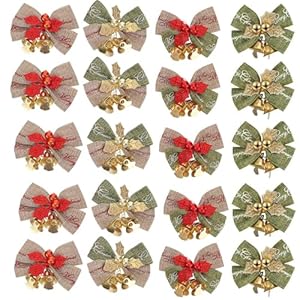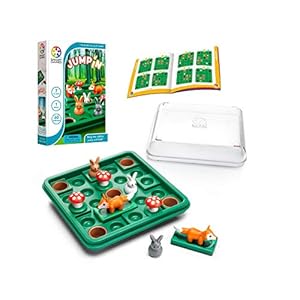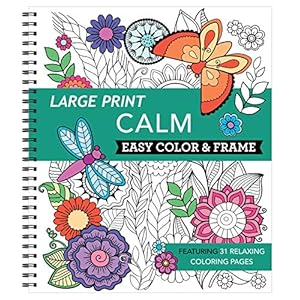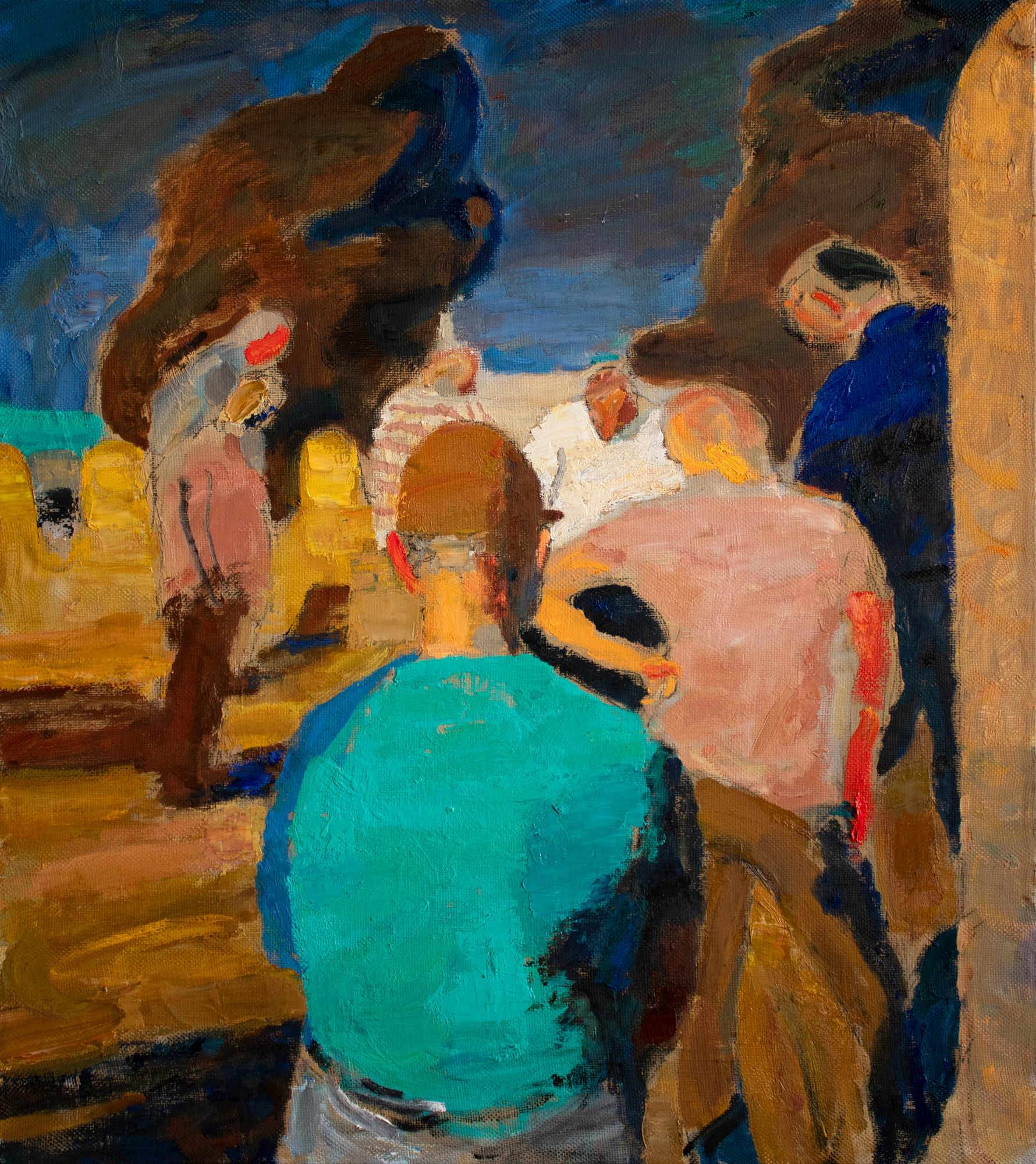
Samir Rakhmanov won Anita Klein’s Choice Award in Jackson’s Art Prize this year with his work A Burial. In this interview, he discusses his shift from realistic to expressive painting, making the most of daylight, and finding beauty within grief.
Above image: Samir in the studio

A Burial, 2024
Samir Rakhmanov
Oil on canvas, 90 x 80 cm | 35.4 x 31.4 in
Josephine: Could you tell us about your artistic background?
Samir: I was born in a small town of Pavlohrad in Ukraine, but grew up in Baku, Azerbaijan. When I was a kid, I liked drawing – but honestly, nothing worth framing. My parents, being optimistic, put me in a small art school that had art lessons alongside regular subjects. That experiment didn’t last long, and I ended up in a regular middle school. For a few years after that, I barely drew at all. Then, in 8th grade, something clicked. I got hooked on drawing again, this time with a focus on manga, video game concept art, and illustration. That was the first time I thought, “Alright, maybe this is what I want to do”. A few years later, I got a graphic tablet and started doing a ton of digital painting.
By the time I finished middle school, my goal was to try and study art in the UK or US, focusing on concept art and illustration for the entertainment industry. Unfortunately, tuition in those countries was far too expensive for my family.

Working on a large canvas painting
While looking for plan B, I stumbled on a thread on the ‘conceptart.org’ forum (which was the place for digital artists back then) about this Russian classical art academy where students painted and drew from life, like in the 19th century. I couldn’t believe a place like that still existed. And the level of skill I saw was mesmerising. I decided to apply to the Saint Petersburg Academy of Arts. The only problem? I had zero traditional painting and drawing skills. My first attempt at the entrance exams… let’s just say it was humbling. Even though I had spent a whole year in a preparatory course for it. So for my second try, I spent the next year working like crazy to prepare, and on my second try, I got in.
That was the start of six years of the most intense art training you can have – nine hours a day painting and drawing from life, then working on composition assignments at night. Summers in the academy were spent on plein air trips and in museums copying original master paintings. I had great teachers who inspired me, challenged me, and passed on their skills and knowledge. Studying alongside other dedicated students pushed me even further. I switched fully to traditional painting and realized I couldn’t imagine my life without it. And I actually managed to graduate with honors. And I’m super lucky to make a career as both a painter and a teacher myself.
And as the time has passed, I started shifting from fully realistic painting to a more formalistic and expressive approach in my own art.

In the studio. Going through the paintings
Josephine: What does a typical working day in the studio look like for you? Do you have any important routines or rituals?
Samir: I try to be in the studio every day, even if I don’t have much to work on. Just being there has become a ritual in itself. And I rent the studio with a few other artists, so sometimes we just chat through the whole day. On the way, I always pick up a cup of coffee – and usually another one or two later in the day.
The first hour is usually dedicated to my students. I teach online, so I spend that time reviewing their work, writing feedback, and doing overpaints. If I’m running a full online course, that can easily take up half the day, sometimes the whole day. When the teaching’s done, I switch over to my projects. If I have commissions, they get priority before I dive into personal work.
I try to make the most of daylight, because I’m not a fan of painting under artificial light. My studio lighting is excellent and colour-accurate, but for me, nothing compares to natural light. So I do most of the painting until sunset. Although in winters in Saint-Petersburg you don’t get much daylight at all, so working with artificial light becomes the only way during that time.
One of my small but important rituals happens at the end of the day: I always clean my palette. I put any leftover paint onto a separate board and wipe the palette completely clean. I made this decision back in my academy days – before that, my palettes were in such a horrendous state they needed to be replaced or thoroughly cleaned. Since making it a habit, I’ve never skipped it once, and it makes mixing colours so much easier.
The next good habit I need to master is cleaning my brushes after work, but let’s just say I’m still a work in progress there.
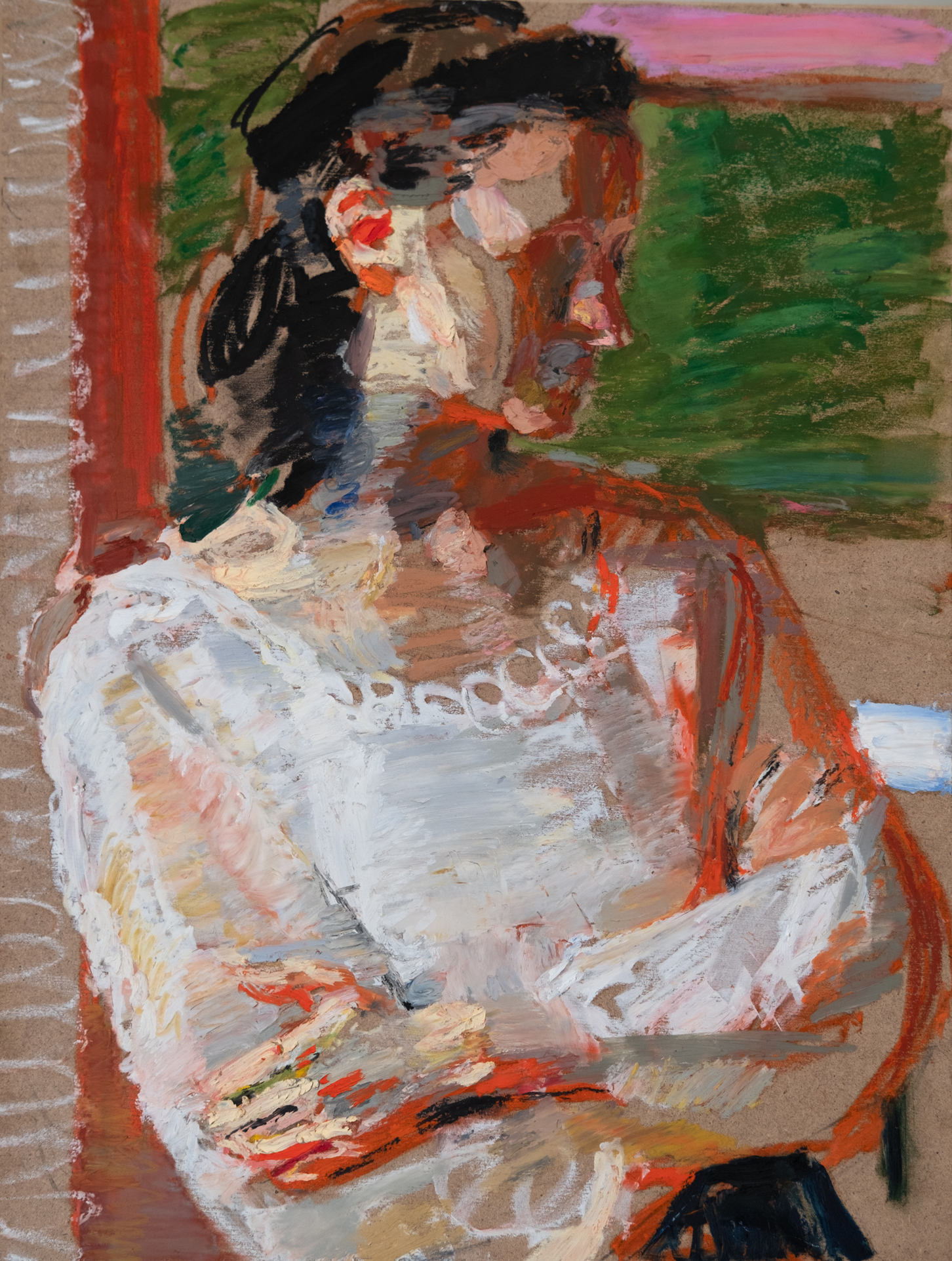
Portrait Composition, 2024
Samir Rakhmanov
Oil pastel on hardwood, 40 x 30 cm | 15.7 x 11.8 in
Josephine: Which materials or tools could you not live without?
Samir: Oil paint is my main material. Most of my brushes for oil painting are bristle brushes, because I’m not a fan of the texture synthetic ones leave in the brushstroke.
For the past seven years, I’ve also been working a lot with oil pastels — to the point where I use them more often than anything else. They’re incredibly versatile, and I love how direct and physical they feel. I’ve been experimenting with different brands, and of course, Sennelier Oil Pastels are unmatched. Although there have been some nice Chinese manufacturers like Kuelox, which are a great cheaper alternative to Sennelier, as they are also really creamy and soft (softer than anything else besides Sennelier). For quick plein air sessions or sketches, I sometimes use gouache, especially if I don’t have oil pastels with me, or if I want that fluid, watery quality in a painting.
For drawing and sketching, charcoal is my go-to, both in pencils and sticks. I’m especially fond of charcoal pencils by Conté à Paris (actually, almost all of their pencils). They’re thicker, sturdier, and have this beautiful warm tint to the charcoal that I really like.
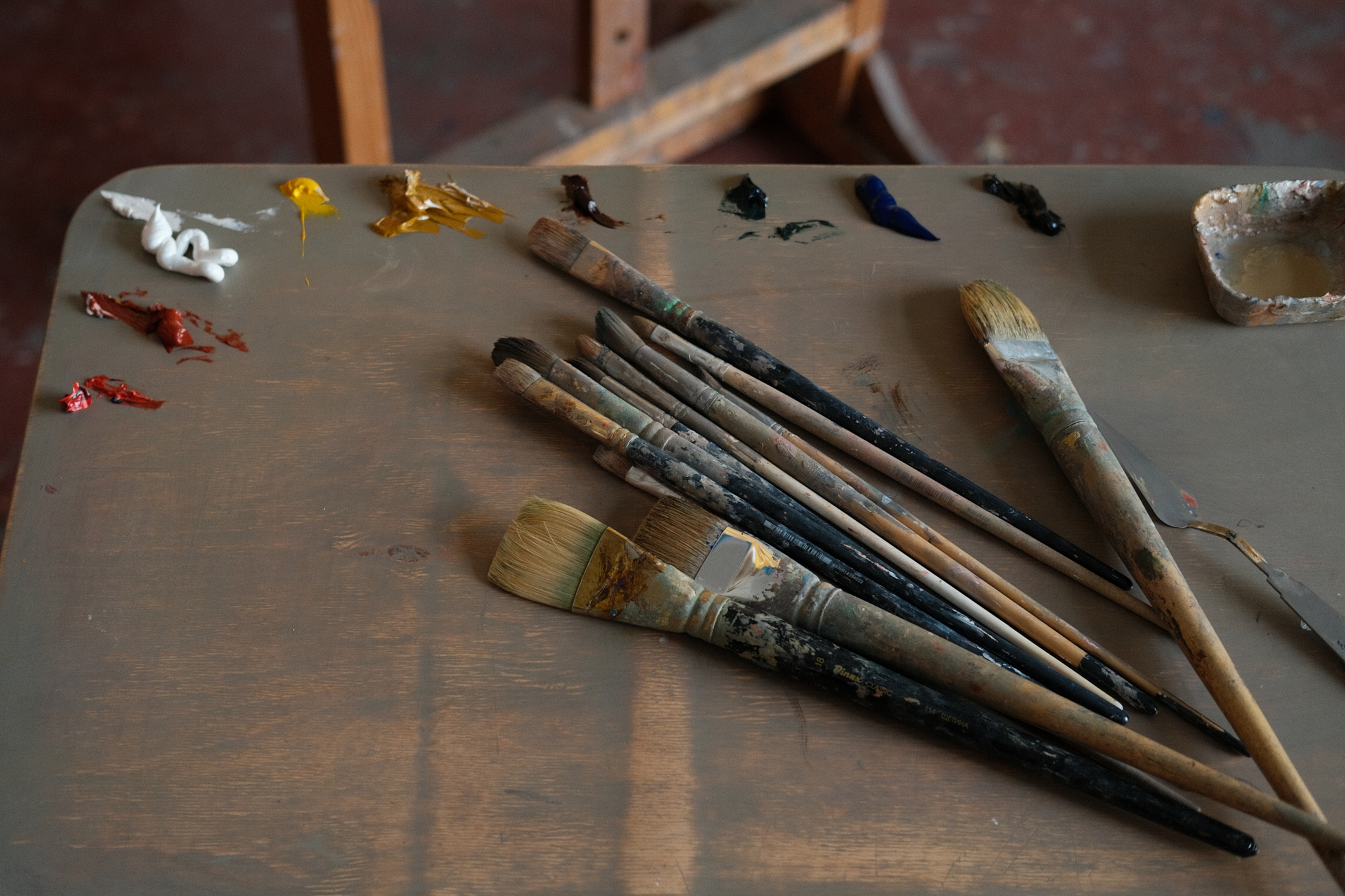
Palette with brushes
Josephine: Do you work from a reference? What is your process?
Samir: Yes, I do. Referencing the world around me is essential to my work. My inspiration comes from what I see and experience, so I do a lot of sketches from life, and paint from life whenever I can. For larger, more complex paintings, I usually take my own reference photos, and if that’s not possible, I’ll sometimes look for images online.
My process often begins with a compositional pencil sketch, usually done without much reference, just to get the idea down. From there, I move on to colour sketches and then gather photo references. All of these, life studies, colour sketches, and photos, become part of the reference pool I work from when creating a big piece.
This approach comes directly from my time at the Academy, where we had to create realistic academic figurative paintings. You needed multiple references and strong life drawing to give the work real persuasiveness. Especially if it’s a historic painting, gathering references is crucial. For my academic diploma painting Parisian Cafe, I went on a two-week working trip to Paris, to paint plein air on the streets, sketch, and photograph.
Even now, working in a more semi-abstract style, I still make sure there’s always something solid to lean on.

Into The Sea!, 2024
Samir Rakhmanov
Oil on canvas, 45 x 60 cm | 23.6 x 15.7 in
Josephine: Do you regularly draw or keep a sketchbook? If so, how does this inform your work?
Samir: I’ll be honest, I don’t draw as much as I should. I wouldn’t say I draw regularly, and I wish I did. There’s always something else that needs attention: a painting to finish or a new one to start. I used to sketch much more – on public transport, or at life drawing sessions. Now, that’s become rare.
These days, I might sketch portraits of people around me if I have spare time and a sketchbook handy. For me, life sketching is like muscle training — it keeps my drawing and observational skills sharp. And I’ll admit, I don’t train those muscles as often as I should.
What I do more of now is compositional sketching: trying out new ideas, testing different arrangements, and seeing what works. For that, even a scrap of paper can be enough — and I have piles of old, cheap paper lying around my studio. Of course, I also keep sketchbooks for travel and more organised work.
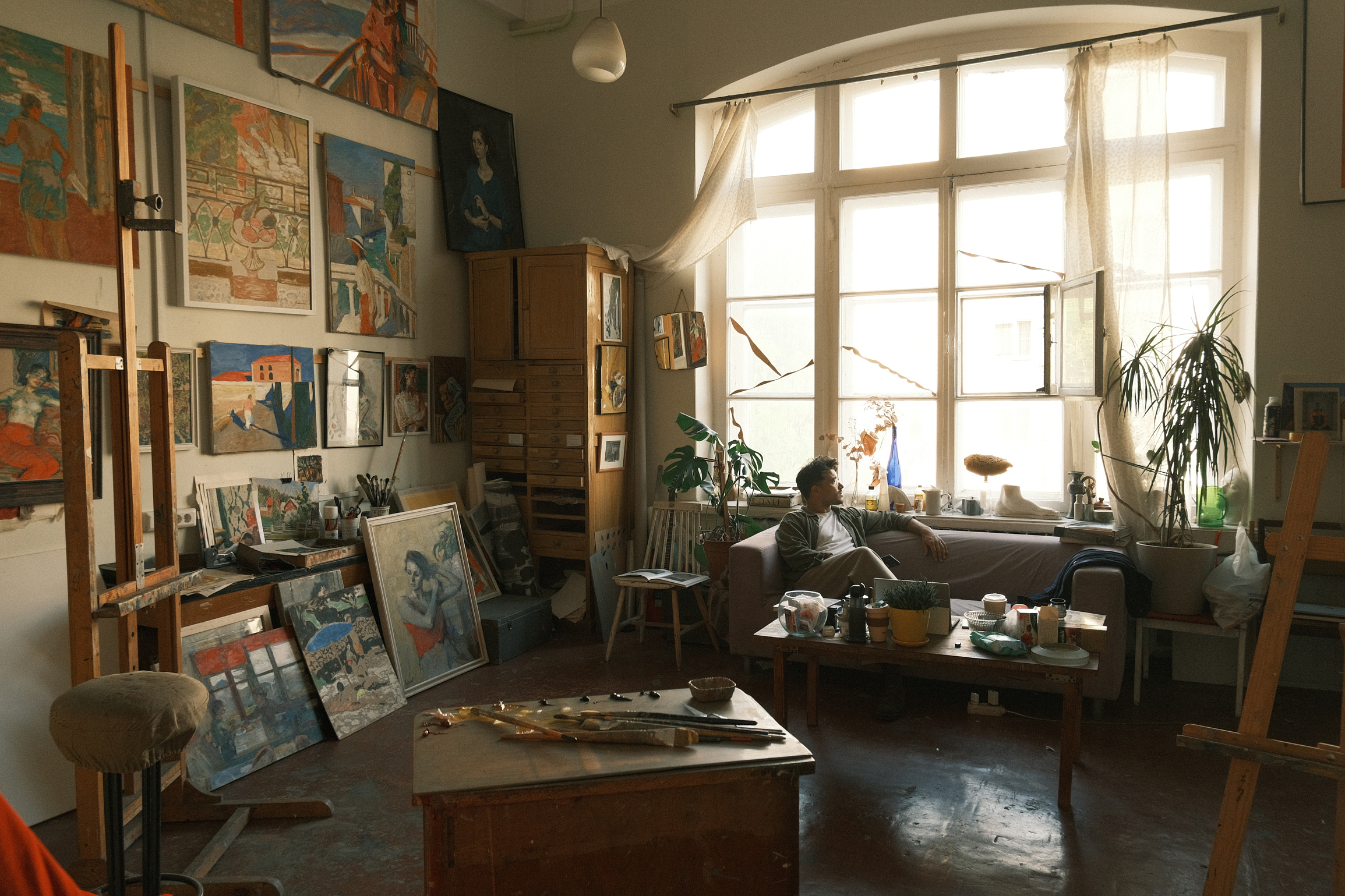
Studio space
Josephine: Have you ever had a period of stagnation in creativity? If so, what helped you overcome it?
Samir: Yes, I go through creative stagnation fairly often. What usually gets me moving again is looking outward – paying closer attention to the world around me, or revisiting personal memories. Sometimes it’s as simple as spending time with the work of artists I admire. Visiting museums helps too – being surrounded by beautiful art, and seeing how varied and inventive it can be, always sparks something in me.

Transferring the sketch to a big canvas using charcoal
Josephine: Are there any specific artists or mentors who have inspired you?
Samir: When I was at the Academy, I was deeply inspired by artists like Valentin Serov, Diego Velázquez, Titian, Ilya Repin, and other realist painters. I aspired to capture reality the way they did, and that focus shaped my ability to paint from life with some level of accuracy.
At the same time, I began exploring the Impressionists and Post-Impressionists. Over time, my attention shifted toward artists such as Édouard Vuillard, Pierre Bonnard, and Henri Matisse. I also became increasingly fascinated by 20th-century painters who managed to combine figuration with abstraction, achieving a wonderful sense of freedom while keeping a recognizable subject. Richard Diebenkorn, in particular, stood out for me – his balance of structure and looseness had a big impact on how I think about painting today.
As for mentors, I was fortunate to have exceptional painting teachers at the Academy. My first-year teacher, Daria Kollegova, pushed me out of my comfort zone immediately. She opened my eyes to the wider world of art beyond the Academy’s walls – bringing in books and albums, and walking us through the works of different artists. Igor Petrov was another major influence, teaching me the intricacies of portrait painting and composition. He always emphasized sharp composition and embraced challenges. Then I studied for three years under Yuri Kalyuta, a master of expressive painting, who constantly reminded us to look for the decorative foundation in a work, to make it more picturesque and engaging.

Figure at the Window, 2025
Samir Rakhmanov
Oil on cardboard, 68 x 84 cm | 26.7 x 33 in
Josephine: What were you thinking about or exploring at the time you painted A Burial? What inspired it, and how did it come to be?
Samir: The piece came out of my personal experience of losing loved ones. In moments of grief, I found myself unexpectedly struck by a certain kind of beauty that can exist in something as solemn as a burial. It’s almost theatrical in the sense that it brings many people together in a shared, synchronised act filled with emotion, but unlike theatre, the emotion is completely pure and unperformed.
In Muslim tradition, burial is simple. The body is washed, wrapped in a white shroud, and interred as soon as possible, often the same day. People attending usually wear their everyday clothes, often colourful, rather than formal black. Sometimes, the whole process can happen on a warm summer evening, during golden hour. That combination – mourning, silence, the movement of many people working together, their bright clothes glowing in soft sunlight – created a vivid contrast in my mind. It made me want to depict the scene using bold, rich colours instead of a monochrome palette, to capture the sensation of light and beauty while preserving the weight of the mournful moment.
I wrestled with the piece for two years. At first, I only managed sketches before realizing I couldn’t yet achieve what I envisioned. Then, after experiencing another loss a year later, the memory and the feeling reignited, and I finally found the resolve to complete it.

Working on an oil pastel sketch
Josephine: Why did this piece feel like the right one to submit?
Samir: I submitted several works, aiming for variety, but one of my main criteria was simply that I had to genuinely like the piece myself. With A Burial, I felt I had finally achieved something I’d been trying to capture for a long time. It also reflects a new direction in my work – a shift in approach and sensibility – so it felt like a strong representation of where I am as an artist right now.

Parisian Cafe, 2020
Samir Rakhmanov
Oil on canvas, 150 x 270 cm | 106 x 59 in
Josephine: How did it feel to realise you had won Anita Klein’s Choice Award?
Samir: It was incredibly exciting! This wasn’t my first time participating, and after so many years of trying, finally reaching the final and receiving an award truly made my day, my week, my month, maybe even my year. It felt great to know that others saw something in this painting and connected with it. It’s always rewarding to have your work appreciated, and I’m very grateful to Anita Klein for this recognition.

Studio wall
Josephine: In some of your previous works, you’ve used a more subdued colour palette, with an emphasis on neutral tones and blues. This painting features much brighter colours, despite its mournful subject matter. Is this contradiction intentional? Can you discuss the role of colour in your work?
Samir: Yes, the use of bold colours here was very intentional. I wanted to challenge myself to preserve the mournful subject matter while working with intense, saturated tones.
I’ve always been drawn to chromatic contrasts, to playing with colour temperature and exploring different kinds of colour relationships. Colour is central to how I see the world and how I approach my work. When used well, it can make a painting feel alive, giving it energy, motion, and an emotional charge that goes beyond the subject itself.
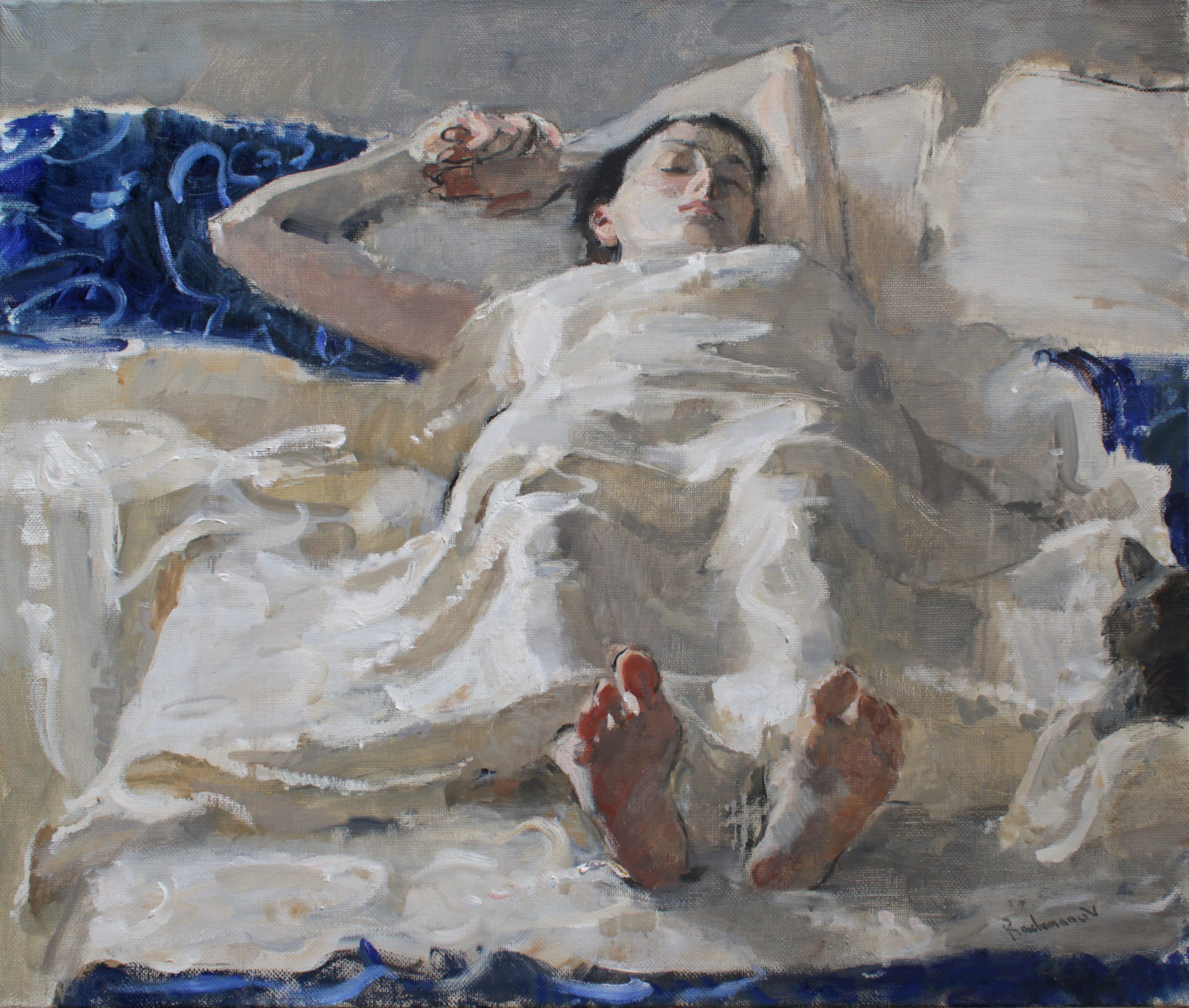
Sleep, 2024
Samir Rakhmanov
Oil on canvas, 80 x 95 cm | 31.4 x 37.4 in
Josephine: Could you talk about your approach to abstracting the human form?
Samir: I approach it from the idea that any image is, at its core, made up of abstract forms. Abstraction is the foundation of everything we see; it’s only when those forms are arranged in certain ways that we start recognising objects and space. So for me, any subject can be deconstructed into abstract shapes. From there, I gradually move from volumetric forms toward flatter, more decorative shapes, simplifying each line and contour. The challenge is to keep enough of the human form for the viewer to identify it, while at the same time creating a unified abstract space that feels ambiguous, harmonious, and visually engaging.

Blue Umbrella, 2025
Samir Rakhmanov
Oil on hardwood, 50 x 60 cm | 19.6 x 23.6 in
Josephine: Are there any new techniques or ideas you’re excited to explore using the materials from your prize?
Samir: Oh yes! I want to try out different types of gouache paints, and it’s time to refill my oil pastel sets. I’m also eyeing some inks, ink pens, and plenty of new sketchbooks. Since I’ll be shipping materials internationally, I can’t get anything flammable, so no solvents for oil paints or fixatives this time. But I’ll be adding a few sets of charcoal and pastel pencils, along with some new brushes. There’s never enough of those!
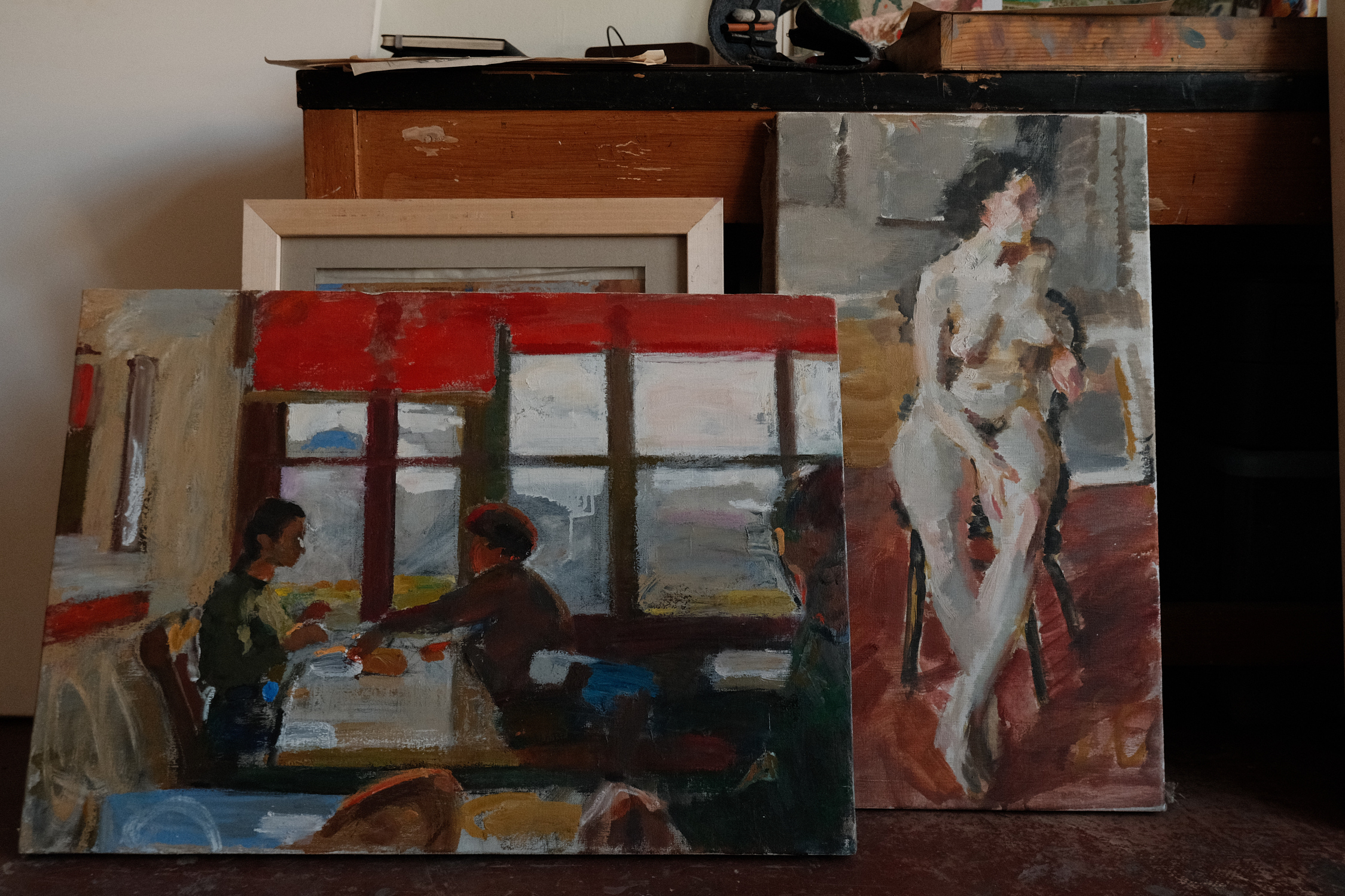
Paintings in the studio
L – R: Lunch in Istanbul and Sitting Nude
Josephine: What’s coming up next for you?
Samir: I’m currently working on a few larger paintings, but over the next month or so, my focus will shift more toward teaching, as I have an online course on oil pastel painting coming up.
In terms of exhibitions, from October through January, two of my works are on view at the European Museum of Modern Art in Barcelona as part of the ‘Figurativas’ exhibition. Looking ahead, one of my goals is to find some gallery representation, and I also hope to take part in future editions of Jackson’s Art Prize with some new work.
Further Reading
Meet Eleanor Johnson, Winner of Jackson’s Art Prize 2025
Jackson’s Art Prize 2025 Exhibition at Affordable Art Fair
How We Collaborate With Artists
Expert Advice on Making Your Way as an Artist
Shop Oil Painting on jacksonsart.com
The post Samir Rakhmanov: Colour’s Emotional Charge appeared first on Jackson's Art Blog.
Trending Products






